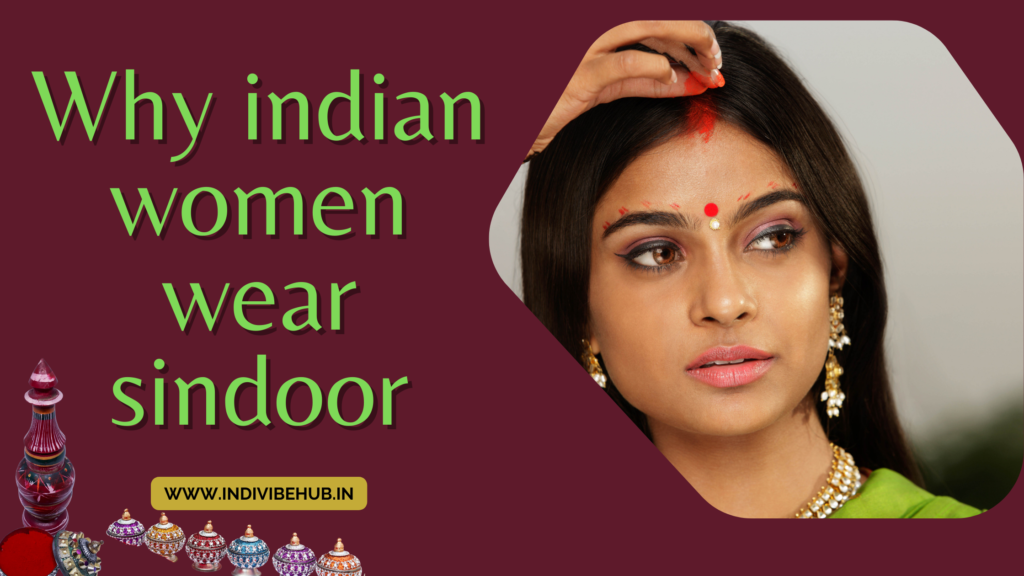India, a land steeped in vibrant traditions and colorful customs, has always fascinated the world with its unique cultural practices. Among these, the use of sindoor holds a special place, especially in the lives of married women. But why do Indian women wear sindoor ? Let’s find the facts in context of Indian culture.
Table of Contents
History of Wearing Sindoor or kumkum
This vermillion powder, often adorned by married women, holds a rich historical significance. Its roots can be traced back to ancient Hindu scriptures and mythology, where it symbolizes the marital status and well-being of a woman.
The use of sindoor dates back to more than 5,000 years and is mentioned in Hindu mythology and the Puranas. One of the earliest mentions of sindoor can be found in the revered epic, the Ramayana, where Sita, the wife of Lord Rama, is believed to have applied it as a mark of her devotion and commitment. The tradition continued through the ages, with sindoor evolving into a potent symbol of matrimony and auspiciousness.

It is also associated with Goddess Parvati, the symbol of marital bliss and the consort of Lord Shiva. Applying sindoor is considered auspicious in Hindu tradition and is a visible expression of the wish for their husband’s longevity.

Cultural and Religious Importance of Sindoor/kumkum
In Hindu culture, sindoor is not just a red powder; it’s a mark of commitment and love. It signifies the marital status of a woman, a tradition that’s been upheld for centuries.
It signifies the eternal bond between husband and wife, with its application considered a prayer for the longevity and prosperity of the marital union. This tradition has transcended religious boundaries, becoming a cherished practice in various communities across India
As women gracefully wear sindoor on their foreheads, they embody a timeless tradition that speaks of love, commitment, and the enduring beauty of cultural customs.
Sindoor/kumkum in Hindu Rituals
The application of sindoor during wedding ceremonies is a pivotal moment. It’s applied by the groom on the bride’s forehead, signifying the start of their married life.

Sindoor is also used in various Hindu festivals and poojas, marking its religious significance. Not only on the special events but also most Hindu married women wear sindoor on daily basis for her husband’s wellbeing.

Sindoor in other religions
Where in Hindu culture, Sindoor holds immense significance for married women, it is not a common practice among Indian Sikhs, some Indian Punjabi Sikh women may choose to wear Sindoor as a cultural or personal choice. It is not mandated by Sikh religious texts but is influenced by regional customs.
Among Jains, particularly in Gujarat and Rajasthan states of India, married women may apply a small dot of Sindoor. This is seen as a symbol of their commitment to marital vows and is considered auspicious.
In some Christian communities in India, especially among the Anglo-Indian population, Sindoor may be adopted by married women as a cultural practice. It is not a religious mandate but reflects the diverse cultural influences in the country. Sindoor is not a tradition in Islam; however, among Indian Muslims, cultural practices can vary.
In Buddhism, particularly among Tibetan communities in India, Sindoor is not a religious symbol. However, cultural practices might vary, and individuals may incorporate regional customs into their lives.
Variations Across Regions
In Northern India, particularly in states like Uttar Pradesh and Bihar, sindoor is often applied as a thick vertical stripe along the parting of the hair. The deep red hue is believed to bring prosperity and is a visible marker of a woman’s married status. The application style, bold and prominent, mirrors the strong cultural traditions upheld in these regions.
Moving towards Western India, in states such as Gujarat and Maharashtra, sindoor is applied in a circular bindi-like fashion on the forehead. The circular shape signifies completeness and is intricately tied to the idea of a fulfilled and harmonious marital life. The sindoor here may have variations in shade, ranging from red to orange, influenced by local customs and preferences.

In the Southern states of India, like Karnataka and Tamil Nadu, sindoor is applied in a more subdued manner. Married women often prefer a thinner, straight line along the parting of the hair. The color intensity may vary, with some regions opting for a brighter red, while others may lean towards a more muted tone. This reflects the diversity not just in application but also in the aesthetics associated with sindoor.
In Eastern India, particularly in states like West Bengal and Odisha, sindoor holds immense cultural significance during religious festivals and marital ceremonies. Married Bengali women traditionally apply sindoor in the shape of a ‘Sohagan’ or a vermilion dot with a white streak extending from it. The combination symbolizes the marital bond and is considered sacred.
Modern Interpretations and debates
Today, the use of sindoor is evolving. While some see it as a sacred tradition, others view it as a personal choice.In modern times, the interpretation of sindoor has expanded beyond its traditional connotations.
Some view it as a personal choice, a form of self-expression, rather than a societal obligation. Many women now wear sindoor as a cultural accessory, embracing it for its aesthetic value rather than solely for its religious implications.
Some argue that the tradition perpetuates gender norms and reinforces societal expectations on women. Critics view it as a symbol of patriarchy, suggesting that women may feel pressured to conform to certain roles and expectations within a marriage.
On the other hand, proponents of sindoor argue that it is a symbol of cultural pride and a personal choice. They emphasize that wearing sindoor should be a decision made willingly, free from external pressures. This perspective sees sindoor as a celebration of cultural identity rather than a symbol of oppression.

Sindoor in Global world
This tradition has traversed borders, with Hindu diaspora and cultural exchange introducing Sindoor to communities far beyond its country of origin.
Similarly, in South Asian and Southeast Asian cultures, Sindoor carries cultural significance. In Bangladesh, Nepal, and parts of Pakistan, married women adorn themselves with Sindoor as a mark of wedded bliss. The custom is a testament to the enduring power of tradition, connecting generations and fostering a sense of identity.
Read also Things You Should Avoid in Indian Culture
Beyond the Indian subcontinent, Sindoor has found its way into global fashion and beauty scenes. Its rich color is embraced in makeup artistry, with cosmetic brands incorporating variations of vermilion into their palettes. The symbolism of Sindoor, with its connotations of love and commitment, has even influenced contemporary wedding rituals in diverse communities.
In recent years, there has been a growing appreciation for cultural diversity, leading to a broader understanding of Sindoor’s significance. Social media platforms have become a catalyst for this cultural exchange, as influencers and content creators share the stories and meanings behind Sindoor, fostering cross-cultural appreciation.
Conclusion
In conclusion, the practice of wearing sindoor by Indian women is a rich and complex tradition, deeply rooted in history and culture. In the modern era, sindoor has become a symbol that encapsulates the complexities of tradition, culture, and personal choice.
The debates surrounding its use highlight the ongoing dialogue between tradition and modernity in Indian society. As the country continues to evolve, so too will the interpretations and discussions surrounding this vibrant red powder, reflecting the dynamic nature of cultural practices in contemporary India.
FAQs
Is Sindoor Mandatory for Indian women?
Contrary to popular belief, wearing sindoor is not mandatory. It varies among individuals and communities, reflecting personal choices rather than societal expectations.
Can Unmarried Women Wear Sindoor?
While sindoor is predominantly associated with married women, cultural shifts have seen unmarried women choosing to wear it for personal or fashion reasons.
Are There Different Types of Sindoor?
Explore the various types of sindoor available, from traditional powder to modern liquid forms, catering to different preferences and lifestyles.
What Does Sindoor Signify in Different Regions?
Sindoor holds diverse meanings across India, with regional variations reflecting unique cultural practices and interpretations.
How to Apply Sindoor Correctly?
Learn the art of applying sindoor correctly, with tips and insights into the traditional techniques passed down through generations.
Does Sindoor Have any Health Benefits?
While sindoor is primarily a cultural symbol, some believe it has medicinal properties. Delve into the cultural beliefs and the scientific perspective on this intriguing aspect.




Many people use their lotteries to improve money for valuable initiatives that improve education, public
infrastructure and social services. Once you play the lottery, you’re
helping to fund these programs while you fund your own ambitions of winning it big.
Have a great time and all the best!
Watch video clips from the guy’s viewpoint to feel like you’re right in the middle of the action and obtain a good view!
You will find big booties in just about any other category you can think of!
Whether you’re into curvy teens, attractive MILFs, or thick
Asians, they all have an area here. Check out
the bouncing, backshots, and amazing action in group
intercourse, gangbangs, anal, one-on-one, and many
more. http://berrybed.ru/bitrix/redirect.php?goto=https://bogazicitente.com/7egpn
awesome
Thanks for any other fantastic article. Where else could anybody get that kind of information in such a perfect
manner of writing? I have a presentation next week, and I
am at the search for such info.
Can I just say what a reduction to seek out someone who actually is aware of what theyre talking about on the internet. You undoubtedly know the best way to bring an issue to gentle and make it important. Extra individuals need to read this and understand this aspect of the story. I cant imagine youre not more common because you definitely have the gift.
This is some awesome thinking. Would you be interested to learn more? Come to see my website at QN9 for content about Airport Transfer.
Thank you for your sharing. I am worried that I lack creative ideas. It is your article that makes me full of hope. Thank you. But, I have a question, can you help me?
I really like your blog.. very nice colors & theme. Did you make this website yourself or did you hire someone to do it for you? Plz reply as I’m looking to create my own blog and would like to know where u got this from. kudos
Superb layout and design, but most of all, concise and helpful information. Great job, site admin. Take a look at my website 63U for some cool facts about Thai-Massage.
Your point of view caught my eye and was very interesting. Thanks. I have a question for you.